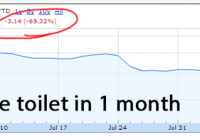OIH: What’s Next For The ETF After Schlumberger, Cameron Intl. Merger?
Market Vectors Oil Services ETF is the largest fund in the oilfield services space with nearly $1.1 billion of assets under management. The fund has outperformed its rivals this year, posted one of its biggest weekly gains last week, and could rise again in the future as M&A activity picks up. Focus now shifts to the fund’s fifth largest holding National Oilwell Varco which could move to acquire FMC Technologies. The slump in oil prices has dragged the oilfield services stocks, but last week, the Market Vectors Oil Services ETF (NYSEARCA: OIH ), posted one of its biggest gains this year as Schlumberger (NYSE: SLB ), the fund’s top holding, announced its decision to acquire Cameron International (NYSE: CAM ), its fourth largest holding. Market Vectors Oil Services ETF is the largest fund in this space with nearly $1.1 billion of assets under management. The fund concentrates on investing in 25 of the largest U.S. listed oil services companies ranging from Schlumberger, to land driller Helmerich & Payne (NYSE: HP ), offshore driller Transocean (NYSE: RIG ), oilfield equipment maker McDermott International (NYSE: MDR ) and fracking sand provider U.S. Silica (NYSE: SLCA ). The fund’s primary strength is its focus on few but well established companies that have significant economic moats. Most of the fund’s underlying holdings have seen several downturns before and are well positioned to face the current one. By comparison, other funds, such as the iShares U.S. Oil Equipment & Services ETF (NYSEARCA: IEZ ) and the SPDR S&P Oil & Gas Equip & Service ETF (NYSEARCA: XES ), have exposure to nearly twice as many companies, but this includes a number of medium to small cap players that have bore the brunt of the oil price collapse. As a result, these funds have underperformed this year when compared against Market Vectors Oil Services. OIH Top Ten Holdings Schlumberger 22.43% Halliburton (NYSE: HAL ) 13.76% Baker Hughes (NYSE: BHI ) 8.57% Cameron International 5.78% National Oilwell Varco (NYSE: NOV ) 5.31% Helmerich & Payne 4.29% Weatherford International plc (NYSE: WFT ) 4.15% Tenaris S.A. (NYSE: TS ) 3.98% FMC Technologies, Inc (NYSE: FMC ) 3.71% Transocean Ltd. 3.12% On a year-to-date basis, Market Vectors Oil Services has fallen by 14.4% while iShares U.S. Oil Equipment & Services and SPDR S&P Oil & Gas Equip & Service have declined by 17.3% and 25.3% respectively. But last week, Market Vectors Oil Services climbed by nearly 13.5% when two of its biggest holdings announced a merger agreement which has been unanimously approved by the boards of the two companies. As I have mentioned in my previous articles ( here and here ), the deal is positive for Schlumberger as well as the offshore drilling industry. But the merger can also open doors to further consolidation in the oilfield services space. And that could push Market Vectors Oil Services higher. The subdued pricing environment, with crude hovering near the low $40s, will force the exit of marginal producers and lead towards industry consolidation with bigger, well established companies buying the weaker ones, just as we’ve seen in every oil cycle over the last three decades. Schlumberger’s purchase should give confidence to other oil service companies who’ve been patently waiting for acquisition opportunities. The four largest stocks of Market Vectors Oil Services, namely Schlumberger, Halliburton, Baker Hughes and Cameron International, are already working towards mega mergers. But investors should watch out for National Oilwell Varco , which provides equipment and components to exploration and production companies. National Oilwell Varco has been struggling in the downturn, but it is one of the oldest and well established companies in the energy sector that has a wide economic moat. Furthermore, the company comes with a solid track record of making bolt-on acquisitions during downturns. In fact, historically, these acquisitions have played a crucial role in fueling the company’s growth. And currently, the company has been actively looking for acquisition opportunities. During the most recent conference call , National Oilwell Varco’s management said that they have already raised the size of their credit facility to $4.5 billion “in preparation for potential [acquisition] opportunities.” There are a number of companies that could be on National Oilwell Varco’s radar such as Dril-Quip (NYSE: DRQ ) and Forum Energy Technologies (NYSE: FET ). But if National Oilwell Varco follows in Schlumberger’s footsteps by buying a company with highly advanced technological capabilities and significant offshore exposure, then there is no bigger name than FMC Technologies which dominates the global subsea equipment market. A potential tie-up would not only give birth to one of the world’s biggest equipment maker in the energy industry, but could also lift Market Vectors Oil Services higher as National Oilwell Varco is the fifth largest and FMC Technologies is the ninth largest holding of the fund. Although Market Vectors Oil Services has struggled this year and could continue to remain under pressure in the near term, at least until we get a clear idea of where the oil price and the 2016 exploration and production budgets are heading, it can prove to be an interesting speculative play on an uptake in mergers and acquisition activity, especially since its underlying companies are actively seeking acquisition opportunities and a merger between National Oilwell Varco and FMC Technologies – two of its ten largest holdings, is very much possible. Disclosure: I/we have no positions in any stocks mentioned, and no plans to initiate any positions within the next 72 hours. (More…) I wrote this article myself, and it expresses my own opinions. I am not receiving compensation for it (other than from Seeking Alpha). I have no business relationship with any company whose stock is mentioned in this article.
